Design and Innovative Application of Ship CCUS Technology Under the Requirements of Green Shipping
Abstract
1. Introduction
2. Design of CO2 Capture System for Marine Vessels
2.1. Analysis of Ship Flue Gas Components and Existing Capture Technology
2.2. Modularized Ship CO2 Capture System Design
2.2.1. Functional Unit Standard Parts Design
- Module A. Flue gas pretreatment (Figure 5)
- Module B. Flue gas reprocessing (Figure 6)
- Module C. CO2 Membrane Separation (Figure 7)
2.2.2. Diversity in System Construction
- Module C. Lap Diversity for CO2 Separation (Membrane Separation as an Example)
- Two-stage: As illustrated in Figure 9, the two-stage structure is typically used to increase the total amount of carbon dioxide separated and the proportion of carbon dioxide separated from the mixture. First, after a series of treatments, the gas enters the first-stage CO2 separation unit. Driven by a certain pressure or concentration difference, CO2 begins to permeate through the first-stage membrane module unit to the opposite side of the membrane, while the remaining gas is retained on the feed side. The separated CO2 gas is drawn by a vacuum pump into the buffer tank unit and then injected directly into the storage module. The retained gas from the first stage is directed via pipeline to the second-stage CO2 separation unit for secondary separation of any remaining CO2.
- Two-stage tandem connection: As illustrated in Figure 10, the tandem structure is primarily used to improve the purity of separated CO2. After the gas undergoes a series of treatments, it enters the first stage of the CO2 separation unit. Driven by a pressure or concentration difference, the CO2 begins to permeate through the first stage membrane module, while the remaining gas is left outside the membrane. Since this retained gas is already clean, it can be uniformly discharged through the external exhaust pipeline. Depending on the pressure on both sides of the membrane, the vacuum pump unit may be activated to accelerate CO2 filtration. The gas is then buffered in the tank and sent to the second stage of the CO2 separation unit. The second stage operates similarly to the first stage, further filtering and purifying the CO2. It is important to note that the materials used for each stage of the CO2 separation process can vary and be customized based on the components and filtration sequence.
- Two-stage parallel connection: As illustrated in Figure 11, the parallel connection structure is primarily used to reduce CO2 separation processing time and increase the amount of CO2 captured simultaneously. When the incoming gas flow rate increases significantly, this method allows for an increased total gas handling capacity of the system. It can be understood as a direct parallel connection of two primary membrane separation units.
- Diversity of the CO2 capture system
2.2.3. Advantage: Modular Design and Standardized Components
- Standardization advantages: Standardized dimensions can facilitate serial and parallel integration, easy installation on fixed-size base supports, and the formation of a “containerized” complete process system. This allows for flexible disassembly, assembly, maintenance, and adjustment across different ship scenarios, ultimately reducing industrial production costs and promoting the development of a dedicated equipment processing industry chain.
- Economic and efficient: The modular design significantly reduces equipment manufacturing, installation, and maintenance costs, improving long-term operational economy.
- High flexibility, small volume, and compactness: Modular design enables each unit to be flexibly assembled or disassembled based on actual flue gas emissions, space layout, and operational needs in different applications.
- High-quantity, high purity, high-speed: Through optimized flue gas pretreatment and multi-stage membrane module separation, the system can efficiently capture CO2 from the incoming flue gas, enhance both the capture rate and purity.
3. Design of CO2 Storage and Transportation System for Marine Vessels
3.1. Design of Small-Sized CO2 Storage Units and Their Fittings
3.1.1. CO2 Storage Unit Group Tank Structure
3.1.2. Auxiliary Safety Devices
3.2. Comparison of Economic Safety of CO2 Storage Unit Size
3.2.1. Comparison Parameters
- Cost per Unit Capacity: the cost of tank construction and operation per unit of storage capacity.
- Mass per Unit Capacity: the mass of the tank per unit capacity.
3.2.2. Comparison Results and Explanation of the Layout of CO2 Storage Units
- Comparison of materials for CO2 storage unit
- CO2 storage unit size (diameter, height) design comparison
3.2.3. Case Analysis
- C-Tank: Due to its large dimensions, this tank must be pre-installed at a designated hull position, leading to significant deadweight tonnage loss. In the early stage of CO2 storage, substantial free space exists inside the tank, resulting in an additional container space occupancy rate of 7.61%. The annual cost of deadweight tonnage loss amounts to USD 12,191,220.
- Individual Containerized Tank: Calculations show that 406 TEU tanks meet the total CO2 storage requirement, with an additional space occupancy rate of 4.56%. The annual cost of lost deadweight ton is USD 7,305,120.
- Small Storage Units in Containers: Due to the more efficient use of container space, 320 TEU with small storage units satisfy the storage requirement, achieving an additional space occupancy rate of only 3.6%. The annual deadweight tonnage loss cost is USD 5,767,200.
3.3. Advantage: Small Size CO2 Storage Unit Group Design
- High use flexibility: By reducing the tank diameter, a higher-pressure design is achieved, enabling the device to safely store CO2. Compared to conventional large-diameter CO2 storage tanks, the system offers more stable and reliable pressure-bearing performance, effectively mitigating safety risks associated with stress concentration within the tank structure. Additionally, the number of CO2 storage units can be flexibly adjusted, allowing the system to be optimized based on actual gas pressure and phase transitions.
- Efficient space utilization and convenient transportation: Multiple CO2 storage units are integrated into standard containers, optimizing the use of container space, enabling a compact layout, and enhancing space utilization. The standard container design also facilitates lifting and transportation, making full use of existing logistics and transportation networks and infrastructure. This design enables efficient transfer, thereby improving equipment mobility and adaptability.
- Almost no downtime maintenance period: In the event of a failure of an individual container CO2 storage unit, it can be bypassed, allowing continued operation with minimal disruption. The equipment maintenance time is extremely short, making it more convenient compared to traditional large CO2 storage tanks. Additionally, this design has almost no impact on the vessel’s normal navigation, CO2 capture, or storage operations.
4. Discussion
4.1. Practical Implementation Constraints and Design Compatibility
- Space and Weight Limitations: Onboard space and deck area is limited, installing CCUS unit can encroach on cargo holds or deck area, especially in retrofits. Careful naval architecture assessments are needed to integrate the CCUS system without exceeding stability and strength limits. Newbuild designs can plan for this from the beginning, whereas retrofitting existing ships is far more challenging, requiring creative use of available spaces and perhaps relocating or upgrading other equipment to make room.
- Power and Utility Integration: CO2 capture systems demand considerable energy and utility support (steam, cooling water, electricity, etc.). The ship’s existing engines and generators must accommodate the parasitic load of carbon capture. These integration issues mean that comprehensive engineering and possibly engine re-tuning are needed when retrofitting CCUS.
- Operational Complexity and Crew Training: Crew members will need to learn the normal operation of the capture plant, routine maintenance, such as replacing filters or membranes, and respond to emergencies such as leaks or high CO2 levels. Updating safety procedures and documentation is essential for safe operation
- Regulatory and Classification Compliance: Since regulations and classification standards are still catching up, shipowners may be reluctant to invest without assured compliance pathways. The ongoing development of IMO’s framework is expected to provide more clarity in the near future.
4.2. Safety and Environmental Risks of Onboard CO2 Storage
4.3. CO2 Offloading Logistics, Infrastructure, and Risks
- Ship-to-Shore: The ideal scenario is a ship arriving at a port equipped with a CO2 reception facility. The vessel would connect to a shore-based tank via insulated cryogenic transfer hoses or loading arms. However, only a few ports involved in pilot projects are installing the refrigerated storage tanks, vaporizers, and pumps needed. Most ports do not have plans to install shore-based tanks until upstream supply and downstream subsurface or usage is clear. Shipowners are depending on a developed discharging network for their onboard CCUS installation.
- Ship-to-Ship: Another approach is transferring the CO2 to a smaller shuttle vessel or barge outfitted to carry LCO2, which then delivers it to a storage hub. This avoids complicated terminal retrofits at every port and instead relies on a few CO2 aggregation vessels shuttling to sequestration sites. This study ranked ship-to-ship and ship-to-shore via an intermediary vessel as the top options for scaling up offloading, since they reduce port-side bottlenecks.
- Containerized (ISO Tank) Offloading: In this approach, captured CO2 is liquefied onboard and pumped into portable tank containers (usually 20- or 40-foot ISO tanks) which are then landed by crane at port and transported by truck or rail. This method is highly flexible and leverages existing container logistics, requiring minimal new infrastructure at the port aside from perhaps a refrigeration hookup to keep the CO2 cold. It is already in use in one system: the Value Maritime OCCS [111], which fills a swap-out CO2 absorption cartridge that is simply offloaded at port.
4.4. Empirical Economic Data and Feasibility Analysis
4.5. Trade-Offs and Design Considerations for Modular CCUS Systems
- Ease of Retrofit and Installation: Modular CCUS units are typically self-contained skids that can be fabricated and tested onshore, then lifted onto the vessel.
- Cost Considerations: Modular units, especially if containerized, open up the possibility of manufacturing in series, turning CO2 capture systems into a commodity that can be produced in factories at lower unit cost. This could drive down prices significantly if demand scales up.
- Deadweight tonnage consumption: Traditional systems are bulky with irregular shapes, often featuring tall towers or tanks. In contrast, modular container-integrated capture systems offer greater practicality and are often preferred by cost-conscious shipowners.
- Performance and Efficiency: A potential drawback of self-contained modular systems is that they might not be as optimized or efficient as a fully integrated system. For example, a containerized capture module might carry its own small CO2 compressor and chiller powered by an independent diesel genset or the ship’s electrical grid, rather than tapping directly into the ship’s main engine waste heat or excess steam.
- Operational management flexibility: A modular system’s failure affects only part of the capture capacity, whereas a single integrated system is a single point of failure for capture functionality. This redundancy aspect may make modular attractive for reliability.
4.6. Regulatory Framework and Incentives (IMO, EU ETS, Etc.)
4.6.1. IMO’s Developing Framework
4.6.2. EU Regulations—Emissions Trading System (ETS)
4.7. Integration with Broader Decarbonization Strategies
4.7.1. Bridge Strategy: Complementary to Alternative Fuels
4.7.2. Integrate with Efficiency Measures
4.7.3. Integrate with Operational Strategies
4.7.4. Integrate with Infrastructure and End-Use Integration
5. Conclusions
- (1)
- This paper designs a “modular OCCS device”, which is more flexible to meet the emission reduction demand and process flexibility adjustment of such mobile carbon sources as ships. Modular design of standardized parts improves the adaptability of OCCS to different flue gas flow rates and working conditions. The series-parallel assembly method is convenient to meet the requirements of incoming gas volume and working conditions, and facilitates the installation, maintenance, upgrading and use in various scenarios, thus reducing the cost of industrial production in the long run.
- (2)
- This paper breaks the cost limitation of low-pressure storage of CO2 in ships by designing a “small-size CO2 storage units” that can be loaded into a standard container, and improves high-pressure storage safety with guaranteed economy. Adopting standard container box as the outer frame instead of traditional large-size storage tanks, it can realize universal transportation, rapid deployment and flexible deployment of quantity, and meet the requirements of different CO2 storage volume and gas pressure phase state. Considering the material cost, pressure strength, weight and other factors of the CO2 storage device, we introduce the two core parameters of “cost per unit capacity” and “mass per unit capacity” to compare the design of different materials and sizes of the CO2 storage unit, and finally calculate the safest and most economical size of the CO2 storage unit.
- (3)
- When the CO2 storage units are arranged in a horizontal grid configuration, the 2 × 2 (: 1030 mm, H: 4300 mm), 3 × 3 (: 690 mm × H: 4700 mm), and 4 × 4 (: 510 mm × H: 4800 mm) configurations are considered the most reasonable layout options based on a balance of safety and economic performance. When the CO2 storage units are arranged in a single-layer vertical configuration, the most favorable outcome is achieved with CO2 storage units having a diameter of 690 mm and a cylindrical height of 1455 mm.
Author Contributions
Funding
Data Availability Statement
Conflicts of Interest
Abbreviations
| CCUS | Carbon dioxide Capture, Utilization and Storage |
| OCCS | Onboard Carbon Capture Systems |
| LNG | Liquefied Natural Gas |
| TEU | Twenty-Foot Equivalent Unit |
| DWT | Deadweight Tonnage |
References
- Crippa, M.; Guizzardi, D.; Banja, M.; Solazzo, E.; Muntean, M.; Schaaf, E.; Pagani, F.; Monforti-Ferrario, F.; Olivier, J.; Quadrelli, R.; et al. CO2 Emissions of All World Countries. JRC Publications Repository. Available online: https://publications.jrc.ec.europa.eu/repository/handle/JRC130363 (accessed on 28 April 2025).
- Chen, S.; Miao, C.; Zhang, Q. Understanding the Evolution of China’s Green Shipping Policies: Evidence by Social Network Analysis. J. Clean. Prod. 2024, 482, 144204. [Google Scholar] [CrossRef]
- IEA. Global CO2 Emissions from Energy Combustion and Industrial Processes and Their Annual Change, 1900–2023—Charts—Data & Statistics. Available online: https://www.iea.org/data-and-statistics/charts/global-CO2-emissions-from-energy-combustion-and-industrial-processes-and-their-annual-change-1900-2023 (accessed on 1 May 2025).
- IEA. CO2 Emissions in 2023—Analysis. Available online: https://www.iea.org/reports/CO2-emissions-in-2023 (accessed on 28 April 2025).
- Luo, X.; Wang, M. Study of Solvent-Based Carbon Capture for Cargo Ships through Process Modelling and Simulation. Appl. Energy 2017, 195, 402–413. [Google Scholar] [CrossRef]
- Fourth Greenhouse Gas Study 2020. Available online: https://www.imo.org/en/OurWork/Environment/Pages/Fourth-IMO-Greenhouse-Gas-Study-2020.aspx (accessed on 28 April 2025).
- Wang, Y.; Cao, Q.; Liu, L.; Wu, Y.; Liu, H.; Gu, Z.; Zhu, C. A Review of Low and Zero Carbon Fuel Technologies: Achieving Ship Carbon Reduction Targets. Sustain. Energy Technol. Assess. 2022, 54, 102762. [Google Scholar] [CrossRef]
- OECD. CO2 Emissions from Global Shipping. Available online: https://doi.org/10.1787/bc2f7599-en (accessed on 1 May 2025).
- Review of Maritime Transport 2024 | UN Trade and Development (UNCTAD). Available online: https://unctad.org/publication/review-maritime-transport-2024 (accessed on 1 May 2025).
- Green Shipping: Innovations, Strategies, And Trends. Available online: https://www.gocomet.com/blog/what-is-green-shipping/ (accessed on 24 May 2025).
- Green Ship: Green Technologies in Shipping Industry. Available online: https://marine-digital.com/article_green_ship (accessed on 24 May 2025).
- IEA. CO2 Emissions from Energy Combustion and Industrial Processes, 1900–2021—Charts—Data & Statistics. Available online: https://www.iea.org/data-and-statistics/charts/CO2-emissions-from-energy-combustion-and-industrial-processes-1900-2021 (accessed on 1 May 2025).
- Joung, T.-H.; Kang, S.-G.; Lee, J.-K.; Ahn, J. The IMO Initial Strategy for Reducing Greenhouse Gas(GHG) Emissions, and Its Follow-up Actions towards 2050. J. Int. Marit. Saf. Environ. Aff. Shipp. 2020, 4, 1–7. [Google Scholar] [CrossRef]
- DNV. Nordic Roadmap Conference Brings Together Partners to Accelerate Decarbonization Through Green Shipping Corridors. Available online: https://www.dnv.com/news/nordic-roadmap-conference-brings-together-partners-to-accelerate-decarbonization-through-green-shipping-corridors-235672/ (accessed on 24 May 2025).
- Tiuttu, T.-A. Green Shipping: What It Is & Why Is It Important. SDG Monitor. Available online: https://www.sdgmonitor.co/post/green-shipping-what-it-is-why-is-it-important (accessed on 24 May 2025).
- World Economic Forum. Green Infrastructure Can Protect Ports from Growing Environmental Risks. Here’s How. Available online: https://www.weforum.org/stories/2022/08/ports-green-infrastructure-environmental-risks-climate/ (accessed on 24 May 2025).
- Future Fuels Nordic—A Nordic Roadmap for Introduction of Zero Emission Fuels in Shipping. Available online: https://futurefuelsnordic.com/ (accessed on 24 May 2025).
- Green Shipping Corridors. C40 Cities. Available online: https://www.c40.org/what-we-do/scaling-up-climate-action/ports-and-shipping/green-shipping-corridors/ (accessed on 24 May 2025).
- Announcements at COP29—Green Shipping Challenge. Available online: https://greenshippingchallenge.org/announcements-at-cop29/ (accessed on 24 May 2025).
- Hua, R.; Yin, J.; Wang, S.; Han, Y.; Wang, X. Speed Optimization for Maximizing the Ship’s Economic Benefits Considering the Carbon Intensity Indicator (CII). Ocean Eng. 2024, 293, 116712. [Google Scholar] [CrossRef]
- IMO Framework on Life Cycle GHG Intensity of Marine Fuels (LCA). Available online: https://www.imo.org/en/OurWork/Environment/Pages/Lifecycle-GHG---carbon-intensity-guidelines.aspx (accessed on 2 May 2025).
- Bilgili, L.; Ölçer, A.I. IMO 2023 Strategy-Where Are We and What’s next? Mar. Policy 2024, 160, 105953. [Google Scholar] [CrossRef]
- Reducing Emissions from the Shipping Sector-European Commission. Available online: https://climate.ec.europa.eu/eu-action/transport/reducing-emissions-shipping-sector_en (accessed on 2 May 2025).
- Xing, H.; Spence, S.; Chen, H. A Comprehensive Review on Countermeasures for CO2 Emissions from Ships. Renew. Sustain. Energy Rev. 2020, 134, 110222. [Google Scholar] [CrossRef]
- Melideo, D.; Desideri, U. The Use of Hydrogen as Alternative Fuel for Ship Propulsion: A Case Study of Full and Partial Retrofitting of Roll-on/Roll-off Vessels for Short Distance Routes. Int. J. Hydrog. Energy 2024, 50, 1045–1055. [Google Scholar] [CrossRef]
- Ustolin, F.; Campari, A.; Taccani, R. An Extensive Review of Liquid Hydrogen in Transportation with Focus on the Maritime Sector. J. Mar. Sci. Eng. 2022, 10, 1222. [Google Scholar] [CrossRef]
- Mao, X.; Ying, R.; Yuan, Y.; Li, F.; Shen, B. Simulation and Analysis of Hydrogen Leakage and Explosion Behaviors in Various Compartments on a Hydrogen Fuel Cell Ship. Int. J. Hydrog. Energy 2021, 46, 6857–6872. [Google Scholar] [CrossRef]
- Schwarzkopf, D.A.; Petrik, R.; Hahn, J.; Ntziachristos, L.; Matthias, V.; Quante, M. Future Ship Emission Scenarios with a Focus on Ammonia Fuel. Atmosphere 2023, 14, 879. [Google Scholar] [CrossRef]
- Fu, H.B.; Shang, G.F.; Lin, J.; Hu, Y.J.; Hu, Q.Q.; Guo, L.; Zhang, Y.C.; Chen, J.M. Fractional Iron Solubility of Aerosol Particles Enhanced by Biomass Burning and Ship Emission in Shanghai, East China. Sci. Total Environ. 2014, 481, 377–391. [Google Scholar] [CrossRef]
- Feng, Y.; Zhu, H.; Dong, Z. Simultaneous and Global Optimizations of LNG-Fueled Hybrid Electric Ship for Substantial Fuel Cost, CO2, and Methane Emission Reduction. IEEE Trans. Transp. Electrif. 2023, 9, 2282–2295. [Google Scholar] [CrossRef]
- Hwang, S.; Jeong, B.; Jung, K.; Kim, M.; Zhou, P. Life Cycle Assessment of LNG Fueled Vessel in Domestic Services. J. Mar. Sci. Eng. 2019, 7, 359. [Google Scholar] [CrossRef]
- Svanberg, M.; Ellis, J.; Lundgren, J.; Landälv, I. Renewable Methanol as a Fuel for the Shipping Industry. Renew. Sustain. Energy Rev. 2018, 94, 1217–1228. [Google Scholar] [CrossRef]
- Ushakov, S.; Stenersen, D.; Einang, P.M. Methane Slip from Gas Fuelled Ships: A Comprehensive Summary Based on Measurement Data. J. Mar. Sci. Technol. 2019, 24, 1308–1325. [Google Scholar] [CrossRef]
- Bicer, Y.; Dincer, I. Clean Fuel Options with Hydrogen for Sea Transportation: A Life Cycle Approach. Int. J. Hydrog. Energy 2018, 43, 1179–1193. [Google Scholar] [CrossRef]
- Rehbein, M.C.; Meier, C.; Eilts, P.; Scholl, S. Mixtures of Ammonia and Organic Solvents as Alternative Fuel for Internal Combustion Engines. Energy Fuels 2019, 33, 10331–10342. [Google Scholar] [CrossRef]
- Korberg, A.D.; Brynolf, S.; Grahn, M.; Skov, I.R. Techno-Economic Assessment of Advanced Fuels and Propulsion Systems in Future Fossil-Free Ships. Renew. Sustain. Energy Rev. 2021, 142, 110861. [Google Scholar] [CrossRef]
- Prussi, M.; Yugo, M.; De, P.L.; Padella, M.; Edwards, R.; Lonza, L. JEC Well-to-Tank Report v5; JRC Publications Repository; Publications Office of the European Union: Luxembourg, 2020. [Google Scholar]
- IPCC. Global Warming of 1.5°C: IPCC Special Report on Impacts of Global Warming of 1.5°C above Pre-Industrial Levels in Context of Strengthening Response to Climate Change, Sustainable Development, and Efforts to Eradicate Poverty, 1st ed.; Cambridge University Press: Cambridge, UK, 2022. [Google Scholar]
- Calvin, K.; Dasgupta, D.; Krinner, G.; Mukherji, A.; Thorne, P.W.; Trisos, C.; Romero, J.; Aldunce, P.; Barrett, K.; Blanco, G.; et al. IPCC, 2023: Climate Change 2023: Synthesis Report; Intergovernmental Panel on Climate Change (IPCC): Geneva, Switzerland, 2023.
- Sheng, X.; Lin, S.; Liang, W.; Xie, H.; Liu, M. Optimal Long-Term Planning of CCUS and Carbon Trading Mechanism in Offshore-Onshore Integrated Energy System. Appl. Energy 2025, 379, 124983. [Google Scholar] [CrossRef]
- Wu, H.; Zhang, X.; Wu, Q.; Zhou, X.; Yue, S. Readiness and Challenges of Carbon Capture Technologies Based on the Shipping Industry. Mar. Pollut. Bull. 2024, 207, 116878. [Google Scholar] [CrossRef]
- Wang, Z.; Lu, M.; Dong, S.; Tang, M.; Yan, X.; Li, K.; Yang, H. Study of Ship-Based Carbon Capture Optimization Considering Multiple Evaluation Factors and Main Engine Loads. J. Clean. Prod. 2024, 478, 143996. [Google Scholar] [CrossRef]
- Tsimplis, M.; Noussia, K. The Use of Ships within a CCUS System: Regulation and Liability. Resour. Conserv. Recycl. 2022, 181, 106218. [Google Scholar] [CrossRef]
- Zhao, T.; Li, R.; Zhang, Z.; Song, C. Current Status of Onboard Carbon Capture and Storage (OCCS) System: A Survey of Technical Assessment. Carbon Capture Sci. Technol. 2025, 15, 100402. [Google Scholar] [CrossRef]
- Stec, M.; Tatarczuk, A.; Iluk, T.; Szul, M. Reducing the Energy Efficiency Design Index for Ships through a Post-Combustion Carbon Capture Process. Int. J. Greenh. Gas Control 2021, 108, 103333. [Google Scholar] [CrossRef]
- Wang, H.; Zhou, P.; Wang, Z. Reviews on Current Carbon Emission Reduction Technologies and Projects and Their Feasibilities on Ships. J. Marine. Sci. Appl. 2017, 16, 129–136. [Google Scholar] [CrossRef]
- Wang, H.; Zhou, P.; Wang, Z. Experimental and Numerical Analysis on Impacts of Significant Factors on Carbon Dioxide Absorption Efficiency in the Carbon Solidification Process. Ocean Eng. 2016, 113, 133–143. [Google Scholar] [CrossRef]
- Fang, S.; Xu, Y.; Li, Z.; Ding, Z.; Liu, L.; Wang, H. Optimal Sizing of Shipboard Carbon Capture System for Maritime Greenhouse Emission Control. IEEE Trans. Ind. Appl. 2019, 55, 5543–5553. [Google Scholar] [CrossRef]
- Zhang, Y.; Xu, H.; Xu, J.; Zhang, X. Advancements and Challenges in Chemical Absorption Technologies for Shipborne Carbon Capture Applications: Absorbent Development, Improvement of Absorption Towers, and System Integration. J. Energy Chem. 2025, 106, 880–910. [Google Scholar] [CrossRef]
- Kotzampasakis, M. Maritime Emissions Trading in the EU: Systematic Literature Review and Policy Assessment. Transp. Policy 2025, 165, 28–41. [Google Scholar] [CrossRef]
- Oh, J.; Anantharaman, R.; Zahid, U.; Lee, P.; Lim, Y. Process Design of Onboard Membrane Carbon Capture and Liquefaction Systems for LNG-Fueled Ships. Sep. Purif. Technol. 2022, 282, 120052. [Google Scholar] [CrossRef]
- Buirma, M.; Vleugel, J.; Pruyn, J.; Doedée, V.; Schott, D. Ship-Based Carbon Capture and Storage: A Supply Chain Feasibility Study. Energies 2022, 15, 813. [Google Scholar] [CrossRef]
- García-Mariaca, A.; Llera-Sastresa, E. Review on Carbon Capture in ICE Driven Transport. Energies 2021, 14, 6865. [Google Scholar] [CrossRef]
- Awoyomi, A.; Patchigolla, K.; Anthony, E.J. Process and Economic Evaluation of an Onboard Capture System for LNG-Fueled CO2 Carriers. Ind. Eng. Chem. Res. 2020, 59, 6951–6960. [Google Scholar] [CrossRef]
- Feenstra, M.; Monteiro, J.; van den Akker, J.T.; Abu-Zahra, M.R.M.; Gilling, E.; Goetheer, E. Ship-Based Carbon Capture Onboard of Diesel or LNG-Fuelled Ships. Int. J. Greenh. Gas Control 2019, 85, 1–10. [Google Scholar] [CrossRef]
- Zhou, P.; Wang, H. Carbon Capture and Storage—Solidification and Storage of Carbon Dioxide Captured on Ships. Ocean Eng. 2014, 91, 172–180. [Google Scholar] [CrossRef]
- Güler, E.; Ergin, S. An Investigation on the Solvent Based Carbon Capture and Storage System by Process Modeling and Comparisons with Another Carbon Control Methods for Different Ships. Int. J. Greenh. Gas Control 2021, 110, 103438. [Google Scholar] [CrossRef]
- Wang, H. Analyzing the Current State and Future Development of Carbon Capture, Utilization and Storage (CCUS) Strategies and Technologies in China. J. Phys. Conf. Ser. 2023, 2608, 012061. [Google Scholar] [CrossRef]
- China Classification Society Releases ‘Shipping Low-Carbon Development Outlook 2023’. Available online: https://www.ccs.org.cn/ccswz/articleDetail?id=202312081257422748 (accessed on 1 May 2025).
- El-Kady, A.H.; Amin, M.T.; Khan, F.; El-Halwagi, M.M. Analysis of CO2 Pipeline Regulations from a Safety Perspective for Offshore Carbon Capture, Utilization, and Storage (CCUS). J. Clean. Prod. 2024, 439, 140734. [Google Scholar] [CrossRef]
- Vakili, S.; Manias, P.; Armstrong, L.-M.; Turnock, S.; Teagle, D.A.H. Technical, Economic, and Environmental Assessment of CO2 Ship Transport in Carbon Capture and Storage. J. Environ. Manag. 2025, 373, 123919. [Google Scholar] [CrossRef]
- Li, J. Accelerating the Offshore CCUS to Carbon-Neutral China. Fundam. Res. 2025, 5, 715–726. [Google Scholar] [CrossRef] [PubMed]
- Al Baroudi, H.; Awoyomi, A.; Patchigolla, K.; Jonnalagadda, K.; Anthony, E.J. A Review of Large-Scale CO2 Shipping and Marine Emissions Management for Carbon Capture, Utilisation and Storage. Appl. Energy 2021, 287, 116510. [Google Scholar] [CrossRef]
- Vessel Characteristics: Ship CLIPPER ERIS (LPG Tanker) Registered in Norway. Available online: https://www.marinetraffic.com/en/ais/details/ships/shipid:5868406/mmsi:257083750/imo:9834727/vessel:CLIPPER_ERIS (accessed on 26 May 2025).
- Vessel Characteristics: Ship STORM (Container Ship) Registered in Antigua Barbuda. Available online: https://www.marinetraffic.com/en/ais/details/ships/shipid:364287/mmsi:305350000/imo:9389435/vessel:STORM (accessed on 26 May 2025).
- GCMD. PROJECT REMARCCABLE (Realising Maritime Carbon Capture to Demonstrate the Ability to Lower Emissions). Available online: https://gcformd.cldy.asia/projects/project-remarccable/ (accessed on 26 May 2025).
- Lim, Y.K.; Lee, S.G.; Ko, M.; Park, K.; Lee, J.M. Operational Strategy of Pre-Cooling Process of CO2 Storage Tank in CCS Ship Transportation Using Model-Based Optimization. Chem. Eng. Res. Des. 2016, 109, 770–779. [Google Scholar] [CrossRef]
- Zhang, T.; Gao, H. Experimental investigation on performance of absorption refrigeration unit under ship swing condition. J. Eng. Thermophys. 2019, 40, 246–251. [Google Scholar]
- Visonà, M.; Bezzo, F.; d’Amore, F. Techno-Economic Analysis of Onboard CO2 Capture for Ultra-Large Container Ships. Chem. Eng. J. 2024, 485, 149982. [Google Scholar] [CrossRef]
- Seo, Y.; Huh, C.; Lee, S.; Chang, D. Comparison of CO2 Liquefaction Pressures for Ship-Based Carbon Capture and Storage (CCS) Chain. Int. J. Greenh. Gas Control 2016, 52, 1–12. [Google Scholar] [CrossRef]
- Sarbanha, A.-A.; Larachi, F.; Taghavi, S.-M.; Thiboutot-Rioux, M.; Boudreau, A.; Dugas, G. Mitigation of Ship Emissions: Overview of Recent Trends. Ind. Eng. Chem. Res. 2023, 62, 1707–1724. [Google Scholar] [CrossRef]
- Gan, L.; Che, W.; Zhou, M.; Zhou, C.; Zheng, Y.; Zhang, L.; Rangel-Buitrago, N.; Song, L. Ship Exhaust Emission Estimation and Analysis Using Automatic Identification System Data: The West Area of Shenzhen Port, China, as a Case Study. Ocean Coast. Manag. 2022, 226, 106245. [Google Scholar] [CrossRef]
- Chen, Y.-F.; Guo, N.; Wu, D.-S.; Hu, R. Numerical Investigation on Immiscible Displacement in 3D Rough Fracture: Comparison with Experiments and the Role of Viscous and Capillary Forces. Adv. Water Resour. 2018, 118, 39–48. [Google Scholar] [CrossRef]
- Vutukuru, S.; Dabdub, D. Modeling the Effects of Ship Emissions on Coastal Air Quality: A Case Study of Southern California. Atmos. Environ. 2008, 42, 3751–3764. [Google Scholar] [CrossRef]
- Corbett, J.J.; Fischbeck, P.S.; Pandis, S.N. Global Nitrogen and Sulfur Inventories for Oceangoing Ships. J. Geophys. Res. Atmos. 1999, 104, 3457–3470. [Google Scholar] [CrossRef]
- Eyring, V.; Köhler, H.W.; van Aardenne, J.; Lauer, A. Emissions from International Shipping: 1. The Last 50 Years. J. Geophys. Res. Atmos. 2005, 110, D17305. [Google Scholar] [CrossRef]
- Lauer, A.; Eyring, V.; Hendricks, J.; Jöckel, P.; Lohmann, U. Global Model Simulations of the Impact of Ocean-Going Ships on Aerosols, Clouds, and the Radiation Budget. Atmos. Chem. Phys. 2007, 7, 5061–5079. [Google Scholar] [CrossRef]
- Endresen, Ø.; Sørgård, E.; Behrens, H.L.; Brett, P.O.; Isaksen, I.S.A. A Historical Reconstruction of Ships’ Fuel Consumption and Emissions. J. Geophys. Res. Atmos. 2007, 112, D12301. [Google Scholar] [CrossRef]
- Endresen, Ø.; Sørgård, E.; Sundet, J.K.; Dalsøren, S.B.; Isaksen, I.S.A.; Berglen, T.F.; Gravir, G. Emission from International Sea Transportation and Environmental Impact. J. Geophys. Res. Atmos. 2003, 108, 4560. [Google Scholar] [CrossRef]
- Corbett, J.J.; Koehler, H.W. Updated Emissions from Ocean Shipping. J. Geophys. Res. Atmos. 2003, 108, 4650. [Google Scholar] [CrossRef]
- Qu, Z.; Kong, Z.; Yin, H.; Zhang, D.; Du, M. Study on carbon capture technology and development trend of exhaust gas from ocean-going ships. J. Environ. Eng. Technol. 2024, 14, 17–24. [Google Scholar]
- Carbon Dioxide Capture and Storage—IPCC. Available online: https://www.ipcc.ch/report/carbon-dioxide-capture-and-storage/ (accessed on 3 May 2025).
- Balcombe, P.; Brierley, J.; Lewis, C.; Skatvedt, L.; Speirs, J.; Hawkes, A.; Staffell, I. How to Decarbonise International Shipping: Options for Fuels, Technologies and Policies. Energy Convers. Manag. 2019, 182, 72–88. [Google Scholar] [CrossRef]
- Miller, D.C.; Litynski, J.T.; Brickett, L.A.; Morreale, B.D. Toward Transformational Carbon Capture Systems. AIChE J. 2016, 62, 2–10. [Google Scholar] [CrossRef]
- Rochelle, G.T. Amine Scrubbing for CO2 Capture. Science 2009, 325, 1652–1654. [Google Scholar] [CrossRef]
- Habibic, A. “World’s First” Ship with Full-Scale Onboard CCS Ready for Pilot Testing. Offshore Energy. Available online: https://www.offshore-energy.biz/worlds-first-ship-with-full-scale-onboard-ccs-ready-for-pilot-testing/ (accessed on 26 May 2025).
- Favre, E. Membrane Processes and Postcombustion Carbon Dioxide Capture: Challenges and Prospects. Chem. Eng. J. 2011, 171, 782–793. [Google Scholar] [CrossRef]
- Scholes, C.A.; Stevens, G.W.; Kentish, S.E. Membrane Gas Separation Applications in Natural Gas Processing. Fuel 2012, 96, 15–28. [Google Scholar] [CrossRef]
- Song, C.; Liu, Q.; Deng, S.; Li, H.; Kitamura, Y. Cryogenic-Based CO2 Capture Technologies: State-of-the-Art Developments and Current Challenges. Renew. Sustain. Energy Rev. 2019, 101, 265–278. [Google Scholar] [CrossRef]
- Tuinier, M.J.; van Sint Annaland, M.; Kuipers, J.A.M. A Novel Process for Cryogenic CO2 Capture Using Dynamically Operated Packed Beds—An Experimental and Numerical Study. Int. J. Greenh. Gas Control 2011, 5, 694–701. [Google Scholar] [CrossRef]
- Jankowski, A.; Grabiec, E.; Nocoń-Szmajda, K.; Marcinkowski, A.; Janeczek, H.; Wolińska-Grabczyk, A. Polyimide-Based Membrane Materials for CO2 Separation: A Comparison of Segmented and Aromatic (Co)Polyimides. Membranes 2021, 11, 274. [Google Scholar] [CrossRef] [PubMed]
- Mehrabi, M.; Vatanpour, V. Polyimide-Based Separation Membranes for Liquid Separation: A Review on Fabrication Techniques, Applications, and Future Perspectives. Mater. Today Chem. 2024, 35, 101895. [Google Scholar] [CrossRef]
- CO2 Removal from Natural Gas & Hydrocarbon Recovery—MTRINC. MTR Industrial Separations. Available online: https://www.mtrinc.com/natural-gas/CO2-removal-from-natural-gas/ (accessed on 1 June 2025).
- Donald Carruthers, J.; Petruska, M.A.; Sturm, E.A.; Wilson, S.M. Molecular Sieve Carbons for CO2 Capture. Microporous Mesoporous Mater. 2012, 154, 62–67. [Google Scholar] [CrossRef]
- Demir, H.; Aksu, G.O.; Gulbalkan, H.C.; Keskin, S. MOF Membranes for CO2 Capture: Past, Present and Future. Carbon Capture Sci. Technol. 2022, 2, 100026. [Google Scholar] [CrossRef]
- Ros, J.A.; Skylogianni, E.; Doedée, V.; van den Akker, J.T.; Vredeveldt, A.W.; Linders, M.J.; Goetheer, E.L.; Monteiro, J.G.M. Advancements in Ship-Based Carbon Capture Technology on Board of LNG-Fuelled Ships. Int. J. Greenh. Gas Control 2022, 114, 103575. [Google Scholar] [CrossRef]
- Dong, C.-Y.; Cho, K.-H. An Optimally Evolved Connective Ratio of Neural Networks That Maximizes the Occurrence of Synchronized Bursting Behavior. BMC Syst Biol 2012, 6, 23. [Google Scholar] [CrossRef]
- Ghorbani, B.; Miansari, M.; Zendehboudi, S.; Hamedi, M.-H. Exergetic and Economic Evaluation of Carbon Dioxide Liquefaction Process in a Hybridized System of Water Desalination, Power Generation, and Liquefied Natural Gas Regasification. Energy Convers. Manag. 2020, 205, 112374. [Google Scholar] [CrossRef]
- Wang, J.; Li, L.; Qu, G.; Cheng, M.; Ren, Y.; Lu, P.; Zhang, T.; Wang, Y.; Wu, F. Advanced Materials for CO2 Capture and Storage: A Comprehensive Review of Current Progress and Future Prospects. J. Environ. Chem. Eng. 2025, 13, 115881. [Google Scholar] [CrossRef]
- Materials of CO2 Storage Tanks—Jianshen Tank. Available online: https://www.jianshentank.com/storagetank/materials-of-co2-storage-tanks.html (accessed on 6 June 2025).
- A Complete Guide to Tank Materials (Updated for 2020). GSC Tanks. Available online: https://www.gsctanks.com/tank-materials/ (accessed on 6 June 2025).
- IMO | Global Integrated Shipping Information System (GISIS). Available online: https://gisis.imo.org/Public/Default.aspx (accessed on 6 June 2025).
- Shipping Intelligence Network. Available online: https://sin.clarksons.net/ (accessed on 6 June 2025).
- Tian, Z.; Zhou, Y.; Zhang, Y.; Gao, W. Design Principle, 4E Analyses and Optimization for Onboard CCS System under EEDI Framework: A Case Study of an LNG-Fueled Bulk Carrier. Energy 2024, 295, 130985. [Google Scholar] [CrossRef]
- Sinotech. Ecochlor. Available online: https://ecochlor.com/sinotech-ccs/ (accessed on 6 June 2025).
- Welcome to REFPROP’s Documentation—REFPROP 10.0 Documentation. Available online: https://refprop-docs.readthedocs.io/en/latest/ (accessed on 6 June 2025).
- Storrs, K.; Lyhne, I.; Drustrup, R. A Comprehensive Framework for Feasibility of CCUS Deployment: A Meta-Review of Literature on Factors Impacting CCUS Deployment. Int. J. Greenh. Gas Control 2023, 125, 103878. [Google Scholar] [CrossRef]
- K STORM, Container Ship, IMO 9389435. Available online: https://www.balticshipping.com/vessel/imo/9389435 (accessed on 25 May 2025).
- Trædal, S.; Stang, J.H.G.; Snustad, I.; Johansson, M.V.; Berstad, D. CO2 Liquefaction Close to the Triple Point Pressure. Energies 2021, 14, 8220. [Google Scholar] [CrossRef]
- GCMD. Our Publications. Available online: https://gcformd.org/our-publications/ (accessed on 1 June 2025).
- Value Maritime’s OCCS Achieves First LR Class Notation on EPS Tanker. Available online: https://bunkermarket.com/value-maritimes-occs-achieves-first-lr-class-notation-on-eps-tanker/ (accessed on 25 May 2025).
- North Sea Port Reports Modest Growth in 2024 World Cargo News. Available online: https://www.worldcargonews.com/ports-terminals/2025/01/north-sea-port-reports-modest-growth-in-2024/ (accessed on 26 May 2025).
- Ros, M.; Read, A.; Uilenreef, J.; Limbeek, J. Start of a CO2 Hub in Rotterdam: Connecting CCS and CCU. Energy Procedia 2014, 63, 2691–2701. [Google Scholar] [CrossRef]
- WorldCargo News. Evergreen Vessel Captures CO2 at Sea. Available online: https://www.worldcargonews.com/news/2024/10/evergreens-container-ship-captures-CO2-at-sea/ (accessed on 26 May 2025).
- OGCI | Project REMARCCABLE | Report. Available online: https://www.ogci.com/project-remarccable (accessed on 30 May 2025).
- Report: VLCC Best Business Case for Onboard Carbon Capture | News | Motorship. Available online: https://www.motorship.com/carbon-capture/report-vlcc-best-business-case-for-onboard-carbon-capture/1476926.article (accessed on 28 May 2025).
- Onboard Carbon Capture and Storage: Pioneering Solution for Ships. Available online: https://www.wartsila.com/marine/products/exhaust-treatment/carbon-capture-and-storage (accessed on 28 May 2025).
- Case Study: Onboard CCS Would Result in 10% Fuel Penalty. Available online: https://www.marinelink.com/news/case-study-onboard-ccs-result-fuel-517971 (accessed on 30 May 2025).
- Tanker Operator Final Report Released of Onboard Carbon Capture Pilot on mr Tanker Stena Impero. Available online: https://www.tankeroperator.com/news/final-report-released-of-onboard-carbon-capture-pilot-on-mr-tanker-stena-impero/14484.aspx (accessed on 30 May 2025).
- Wärtsilä Completes Commercial Launch of Onboard Carbon Capture Solution. Available online: https://article.wn.com/view/2025/05/08/W_rtsil_Completes_Commercial_Launch_of_Onboard_Carbon_Captur/ (accessed on 30 May 2025).
- What Are the Key Considerations for Onboard Carbon Capture? | Hellenic Shipping News Worldwide. Available online: https://www.hellenicshippingnews.com/what-are-the-key-considerations-for-onboard-carbon-capture/ (accessed on 30 May 2025).
- Kok, C. Engineering Study Charts Potential of Carbon Capture Technology to Help Decarbonize Shipping. GCMD. Available online: https://gcformd.org/engineering-study-charts-potential-of-carbon-capture-technology-to-help-decarbonize-shipping/ (accessed on 28 May 2025).
- Maritime Decarbonization Strategy 2022. Maersk Zero Carbon Shipping. Available online: https://www.zerocarbonshipping.com/publications/maritime-decarbonization-strategy (accessed on 28 May 2025).
- Mandra, J.O. Crowley to Trial Carbon Ridge’s Onboard Carbon Capture Solution. Offshore Energy. Available online: https://www.offshore-energy.biz/crowley-to-trial-carbon-ridges-onboard-carbon-capture-solution/ (accessed on 30 May 2025).
- Desai, C. Eastern Pacific Shipping. Available online: https://www.epshipping.com.sg/eps-and-value-maritime-install-carbon-capture-solution-on-mr-tanker/ (accessed on 30 May 2025).
- Marine Environment Protection Committee (MEPC 83), 7 to 11 April 2025. Available online: https://www.imo.org/en/MediaCentre/MeetingSummaries/Pages/MEPC-83rd-session.aspx (accessed on 30 May 2025).
- IMO Data Collection System (DCS). Available online: https://www.imo.org/en/OurWork/Environment/Pages/Data-Collection-System.aspx (accessed on 1 June 2025).
- DNV. Carbon Intensity Indicator (CII): INSIGHTS & Support. Available online: https://www.dnv.com/maritime/insights/topics/CII-carbon-intensity-indicator/ (accessed on 1 June 2025).
- 2023 IMO Strategy on Reduction of GHG Emissions from Ships. Available online: https://www.imo.org/en/OurWork/Environment/Pages/2023-IMO-Strategy-on-Reduction-of-GHG-Emissions-from-Ships.aspx (accessed on 28 April 2025).
- EU Emissions Trading System (EU ETS)—European Commission. Available online: https://climate.ec.europa.eu/eu-action/eu-emissions-trading-system-eu-ets_en (accessed on 30 May 2025).
- First LR Class Notation for Onboard Carbon Capture System Assigned to Eastern Pacific Shipping Tanker | LR. Available online: https://www.lr.org/en/knowledge/press-room/press-listing/press-release/2024/first-lr-class-notation-for-onboard-carbon-capture-system-assigned-to-eastern-pacific-shipping-tanker/ (accessed on 30 May 2025).
- London Convention (LDC,LC) and London Protocol (LP). Available online: https://www.imo.org/en/KnowledgeCentre/IndexofIMOResolutions/Pages/LDC-LC-LP.aspx (accessed on 30 May 2025).
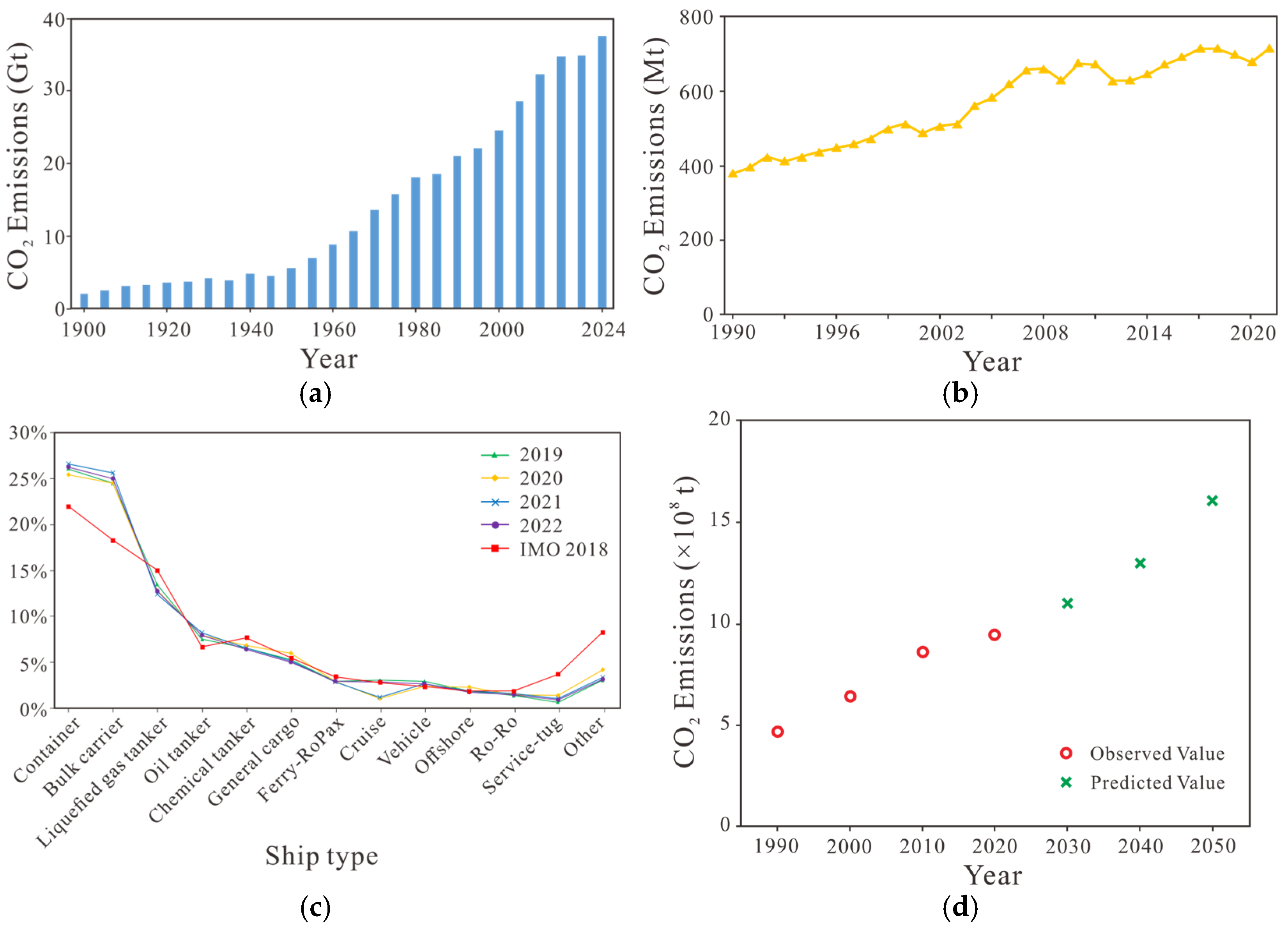
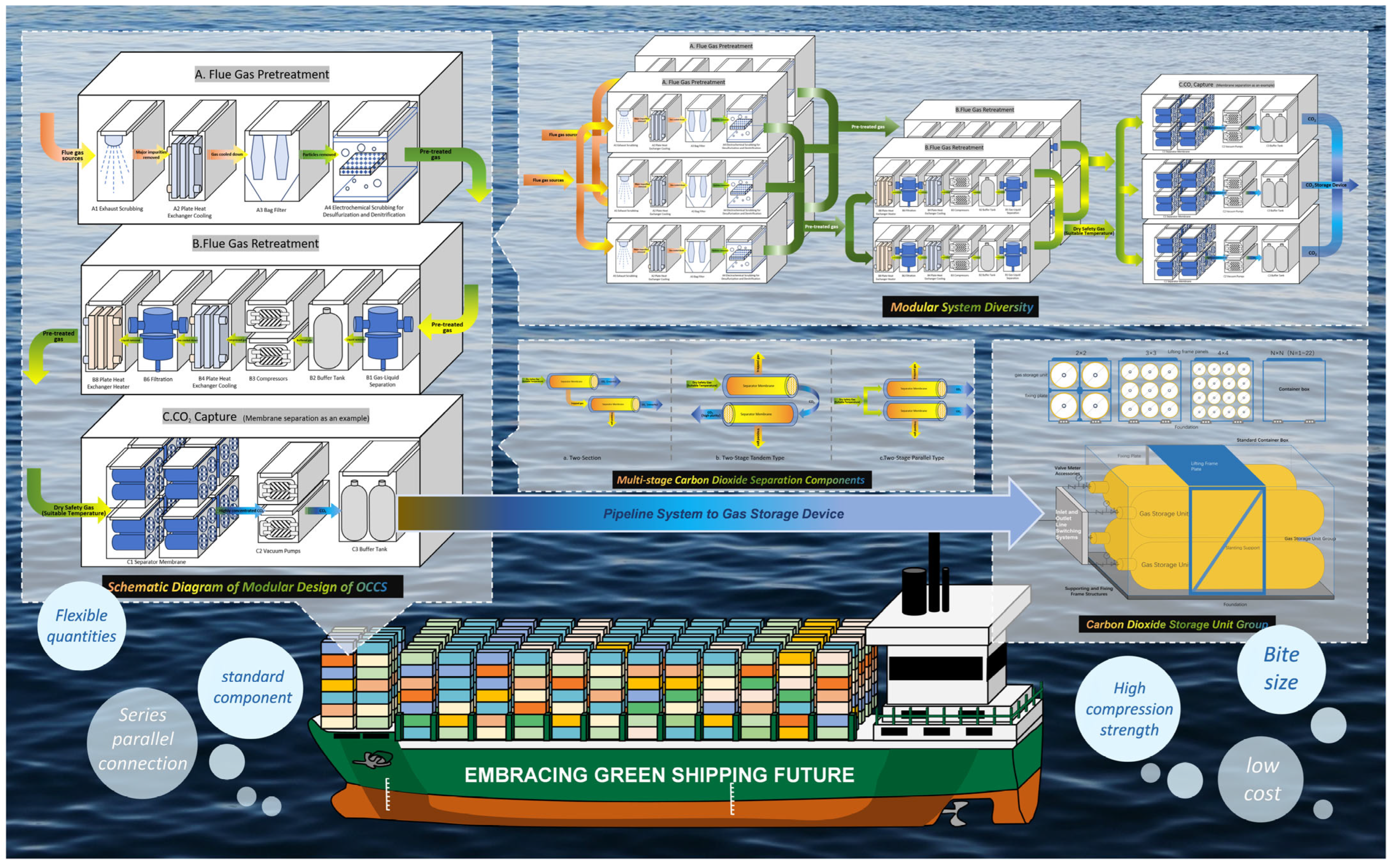
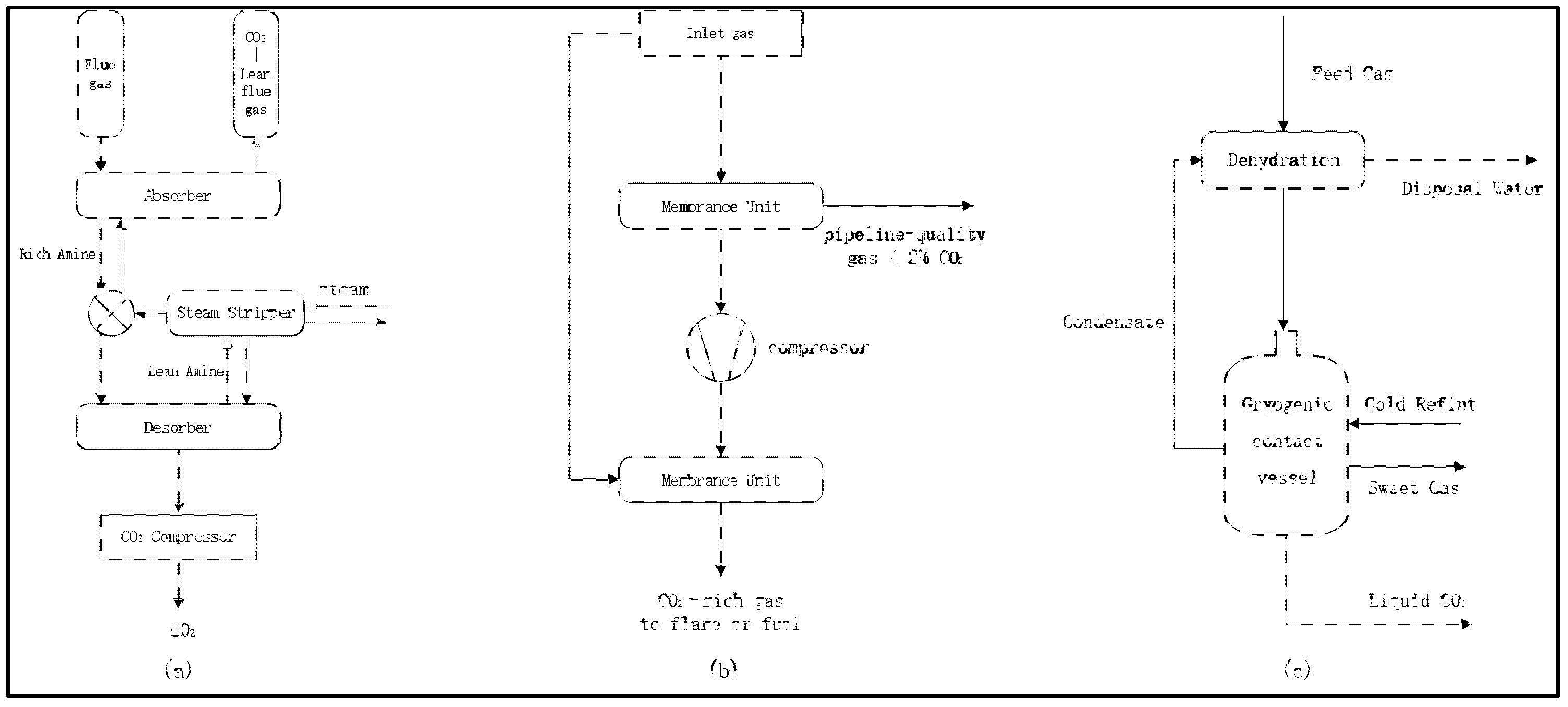
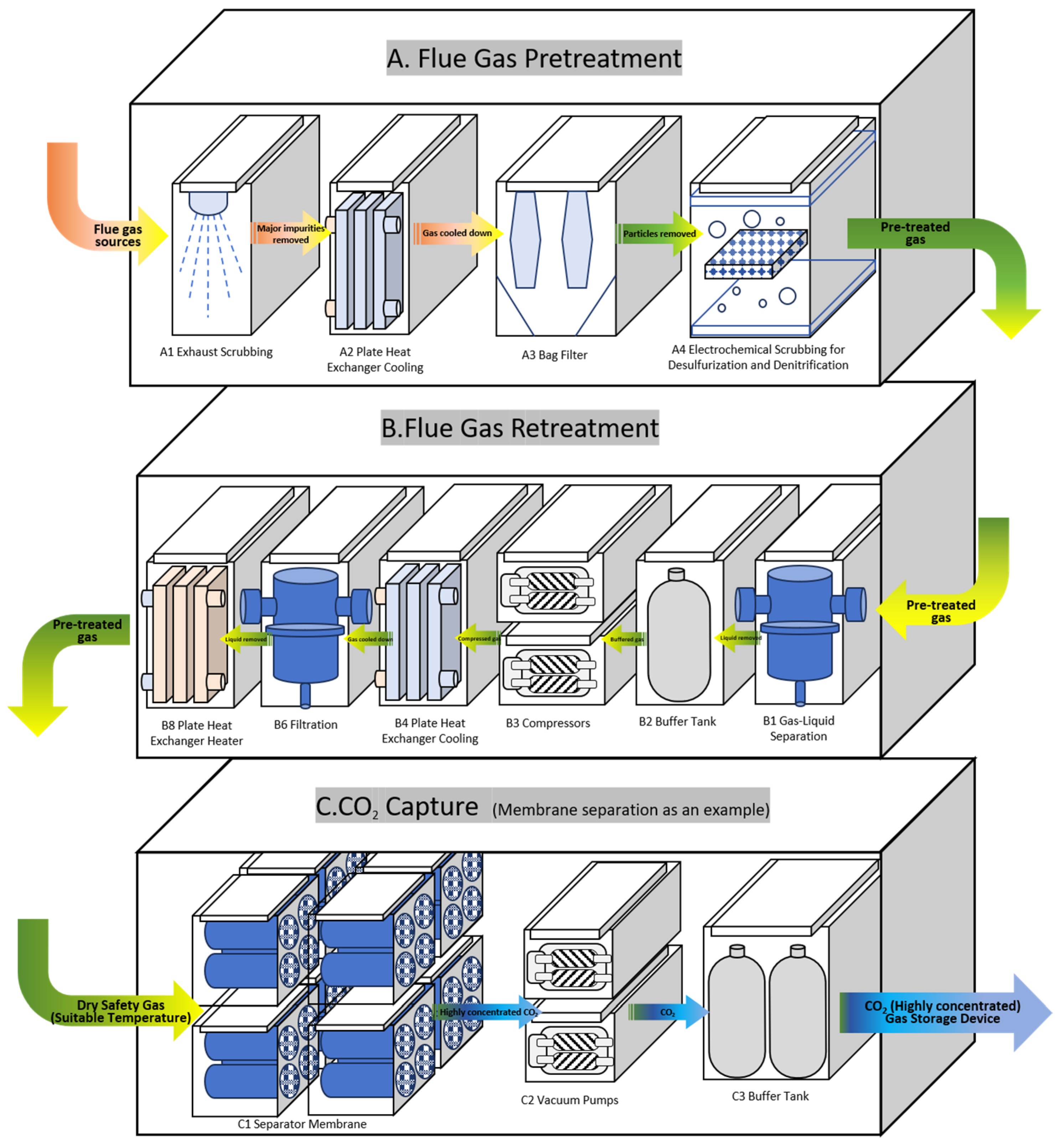


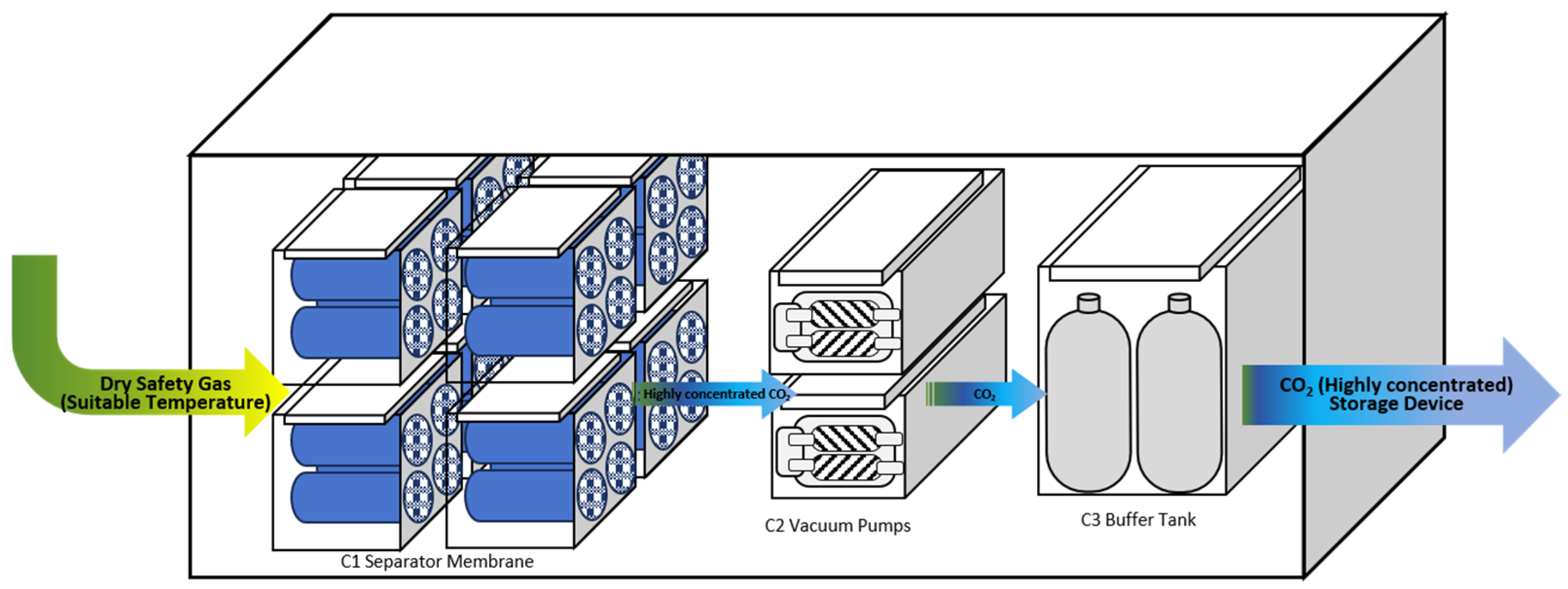

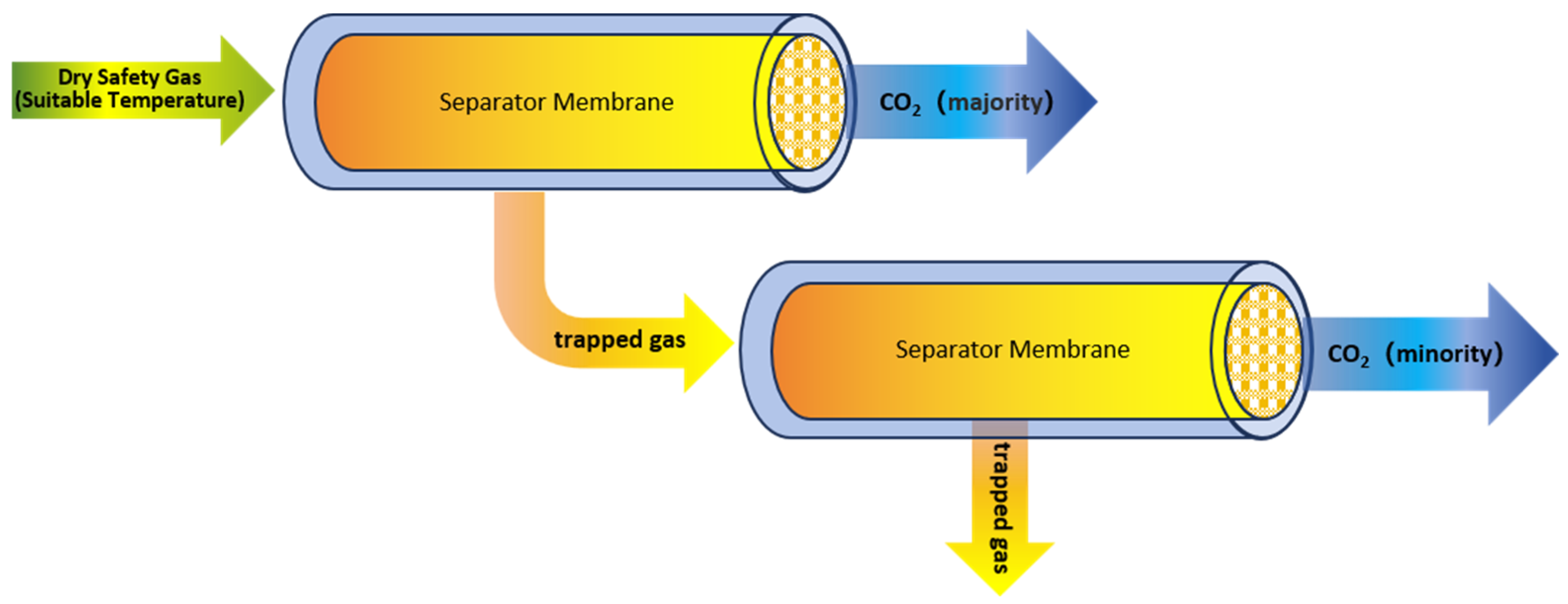

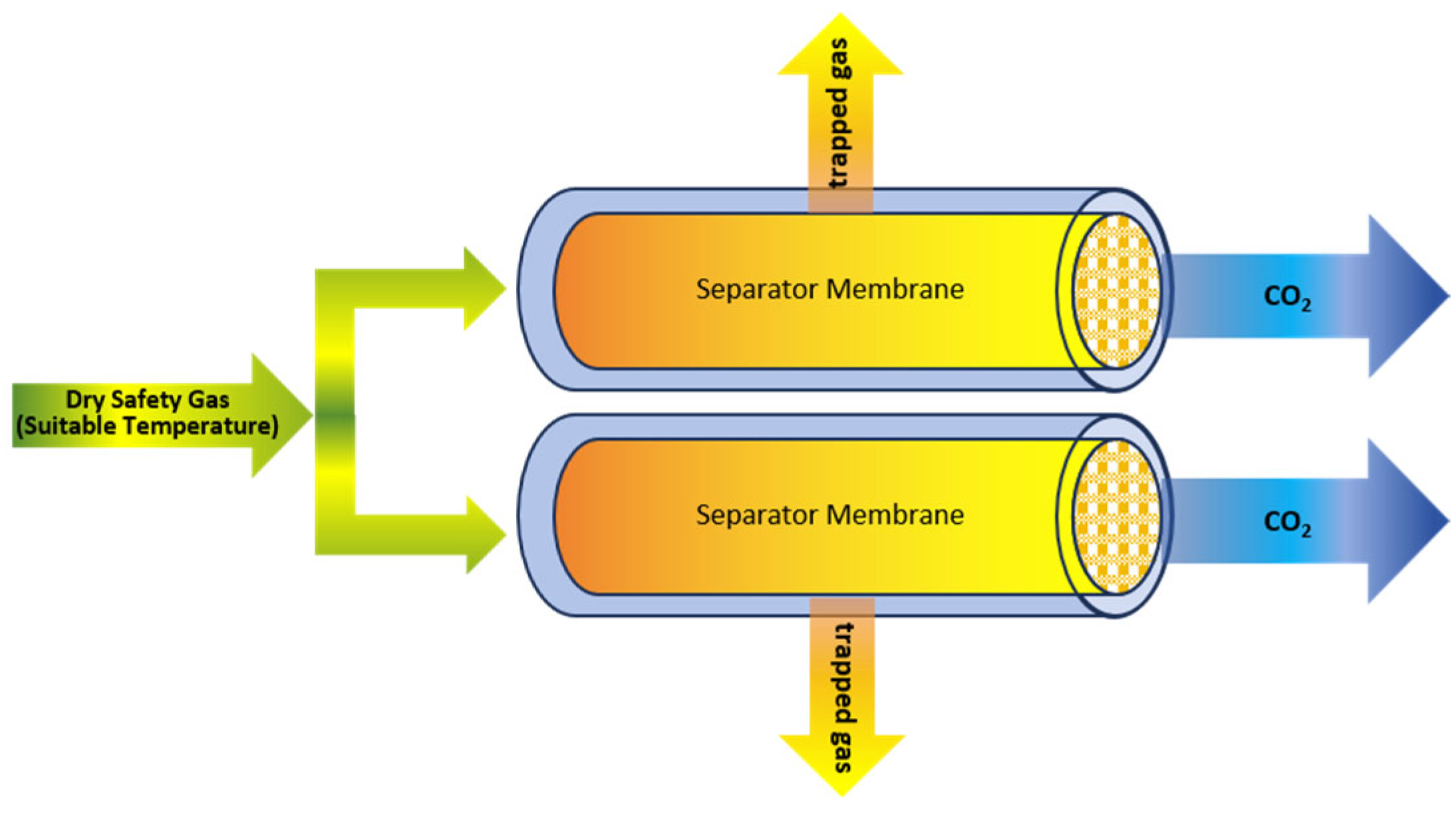

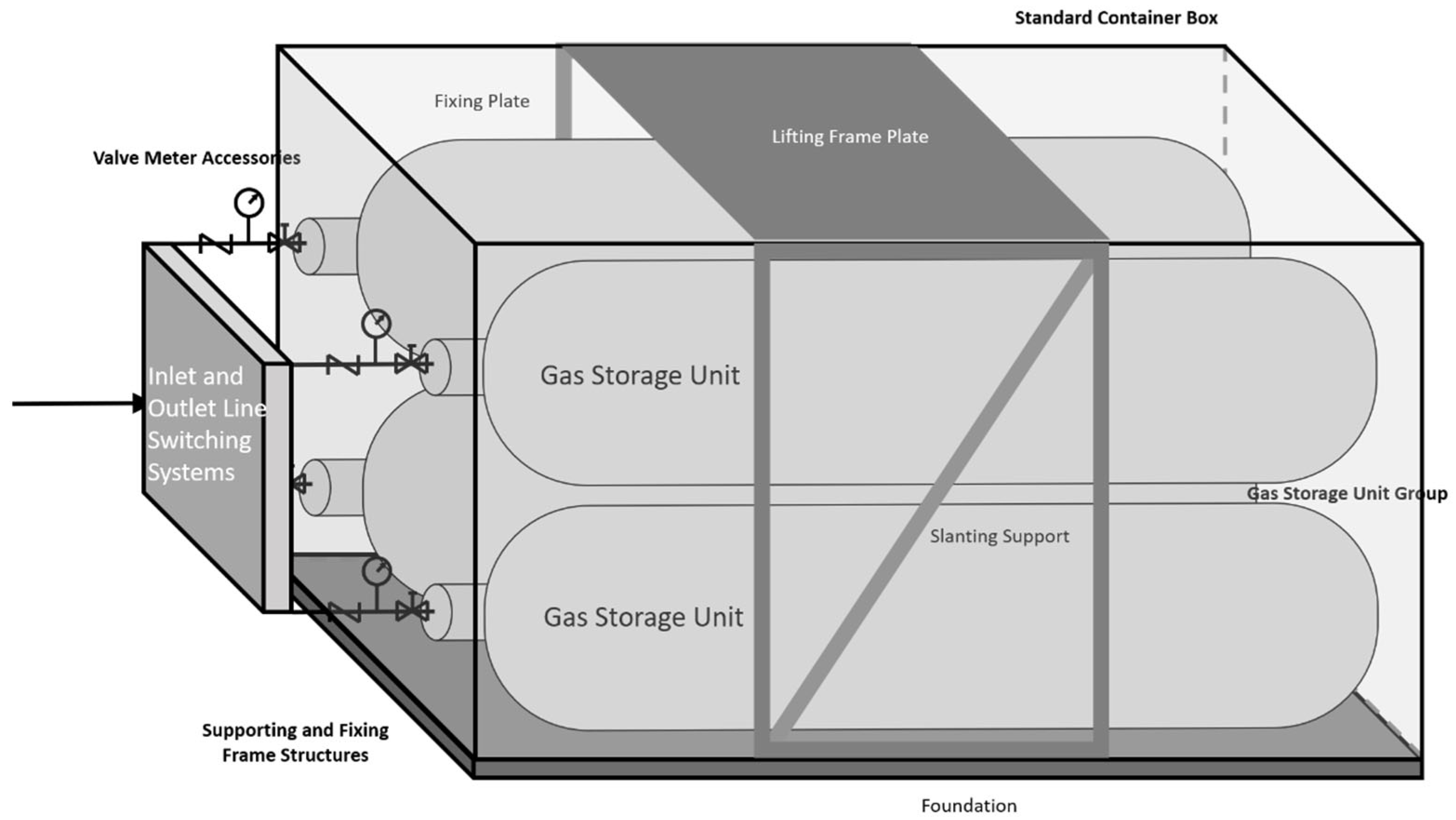





| Methods | Fuel Quantity/Mt | CO2/Mt | NO2/Mt | SO2/Mt | Reference |
|---|---|---|---|---|---|
| Top-down methods | 140~147 | 451 | 10.12 | 8.48 | [75] |
| 200 | 634 | \ | 8.50 | [78] | |
| Bottom-up methods | 166 | 557 | 11.92 | 6.82 | [79] |
| 280 | 813 | 21.38 | 12.03 | [80] | |
| 289 | 912 | 22.57 | 12.98 | [76] |
| Parameter | Chemical Absorption (Amine) | Membrane Separation | Cryogenic Separation |
|---|---|---|---|
| Typical CO2 Capture Efficiency | High (80–90%+) [85,86] | Medium (40–60%) [87,88] | High 90%+ possible [88,89] |
| Energy Requirement/tCO2 | High (~3–4 GJ heat/t CO2) [85] | Low (~150–250 kWh electricity/t CO2) [87,88] | High (~400–600 kWh electricity/t CO2 cooling) [89,90] |
| Footprint and Weight | Large towers, pumps, solvent storage tanks (bulky, heavy) [86] | Compact, modular units (small footprint) [87] | Compact cryocooler and storage tanks, moderate weight [89,90] |
| Operability Issues | Solvent corrosion, solvent degradation, large equipment requires maintenance, complex solvent management [85,86] | Membrane performance affected by impurities, moisture, periodic membrane replacement required [87,88] | Risk of CO2 solidification (dry ice) causing blockages, managing extreme low temperatures, equipment reliability [89,90] |
| CO2 Product Purity | High purity achievable (>99%) [86] | Moderate purity (80–90%), multiple stages needed for higher purity [88] | Very high purity achievable (>99%) [89] |
| Maturity Level | Mature, proven technology in industrial CCS; early marine demonstration projects (Clipper Eris, Stena Impero) [85,86] | Moderate maturity, mature on offshore platform. limited marine deployment experience [87,88] | Proven onshore in industrial settings; limited marine trials, emerging marine applications [89,90] |
| Capture Methods | CO2 Removal Rate/% | Decarbonization Cost/(USD·t−1) |
|---|---|---|
| Chemical absorption method | 90 | 35 |
| Membrane separation method | 92 | 47 |
| Pressure swing adsorption method | 85 | 84 |
| No. | Module | Functional Units |
|---|---|---|
| 1 | Flue gas pretreatment module | exhaust gas scrubbing unit, cooling unit, dust removal unit, desulfurization unit, denitrification unit |
| 2 | Flue gas reprocessing module | gas-liquid separation unit, buffer tank unit, compression unit, cooling unit, gas-liquid separation unit, filtration unit, buffer tank unit, electric heating unit; |
| 3 | CO2 separation module | (taking the “membrane separation” method as an example) membrane module unit, vacuum pump unit, buffer tank unit |
| Material | Price (yuan/t) | Strength (MPa) | Yield Strength (MPa) | Welding Coefficient |
|---|---|---|---|---|
| Q370 | 4200 | 220 | ≥370 | 0.955 |
| Q420 | 4500 | 237 | ≥420 | |
| Q690 | 6000 | 287 | ≥690 | |
| SA517 | 4800 | 331 | 550~860 | |
| Q490RW | 5000 | 254 | ≥490 | |
| Q580R | 5500 | 287 | ≥580 |
| Gross Tonnage/(t) | TEU 1 Standard | TEU Actual | Average Daily CO2 Emission/(t per Day) |
|---|---|---|---|
| 148,667 | 14,000 | 8900 | 292.13 |
| Option | Large C-Tank | 20-Inch Containerized Storage Tank (One) | 20-Inch Containerized CO2 Storage Unit (2 × 2) |
|---|---|---|---|
| Operating temperature and pressure | 238 K 19 bar | 238 K 19 bar | 243 K 40 bar |
| CO2 storage density | 1143.8 Kg/m3 | 1143.8 Kg/m3 | 1085 Kg/m3 |
| storage space required | 7298 m3 | 7298 m3 | 7694 m3 |
| Parameters of equipment | C-Tank 3750 m3 | Single Tank Storage Volume 18 m3 | Single Tank Storage Volume 6 m3 |
| Number of equipment | Two C-Tank | 406 TEU | 320 TEU |
| Additional occupancy rate of container space | 7.61% | 4.56% | 3.6% |
| Annual cost of lost deadweight ton (USD) | 12,191,220 | 7,305,120 | 5,767,200 |
| Project or Study | Ship Type/Size | CO2 Capture Rate | Fuel Penalty | Cap Ex Cost (USD) | Estimated Abatement Cost (USD/ton CO2) |
|---|---|---|---|---|---|
| Stena Impero Pilot (REMARCCABLE Project) | MR (Medium Range) tanker | ~30% [118] | ~10% increase in fuel consumption [118] | 13.6 million | ~769 [119] |
| VLCC Newbuild Feasibility Study (The Mærsk Mc-Kinney Møller Center) | Very Large Crude Carrier (VLCC) | ~75% | ~8% (assumed) | Not stated | 220–290 |
| Wärtsilä OCCS System on Ethane Carrier (Clipper Eris) | Ethane Carrier (Clipper Eris) | ~70% | Not publicly detailed | No data | ~60 [120] |
| Value Maritime System (small-scale modular) | Small Tanker (~10,000–20,000 DWT) | ~20% [121] | Negligible (uses auxiliary boilers) | Lower Cap Ex, but no details | Not available |
Disclaimer/Publisher’s Note: The statements, opinions and data contained in all publications are solely those of the individual author(s) and contributor(s) and not of MDPI and/or the editor(s). MDPI and/or the editor(s) disclaim responsibility for any injury to people or property resulting from any ideas, methods, instructions or products referred to in the content. |
© 2025 by the authors. Licensee MDPI, Basel, Switzerland. This article is an open access article distributed under the terms and conditions of the Creative Commons Attribution (CC BY) license (https://creativecommons.org/licenses/by/4.0/).
Share and Cite
Zhang, N.; Wang, X.; Wang, C.; Peng, Z.; Chen, Y.; Liu, L.; Chen, L.; Hu, J.; Wei, W.; Li, X. Design and Innovative Application of Ship CCUS Technology Under the Requirements of Green Shipping. J. Mar. Sci. Eng. 2025, 13, 1157. https://doi.org/10.3390/jmse13061157
Zhang N, Wang X, Wang C, Peng Z, Chen Y, Liu L, Chen L, Hu J, Wei W, Li X. Design and Innovative Application of Ship CCUS Technology Under the Requirements of Green Shipping. Journal of Marine Science and Engineering. 2025; 13(6):1157. https://doi.org/10.3390/jmse13061157
Chicago/Turabian StyleZhang, Niyu, Xinpeng Wang, Cong Wang, Zhongxiu Peng, Youxiao Chen, Lianhao Liu, Lijie Chen, Jiawei Hu, Wei Wei, and Xuesong Li. 2025. "Design and Innovative Application of Ship CCUS Technology Under the Requirements of Green Shipping" Journal of Marine Science and Engineering 13, no. 6: 1157. https://doi.org/10.3390/jmse13061157
APA StyleZhang, N., Wang, X., Wang, C., Peng, Z., Chen, Y., Liu, L., Chen, L., Hu, J., Wei, W., & Li, X. (2025). Design and Innovative Application of Ship CCUS Technology Under the Requirements of Green Shipping. Journal of Marine Science and Engineering, 13(6), 1157. https://doi.org/10.3390/jmse13061157







